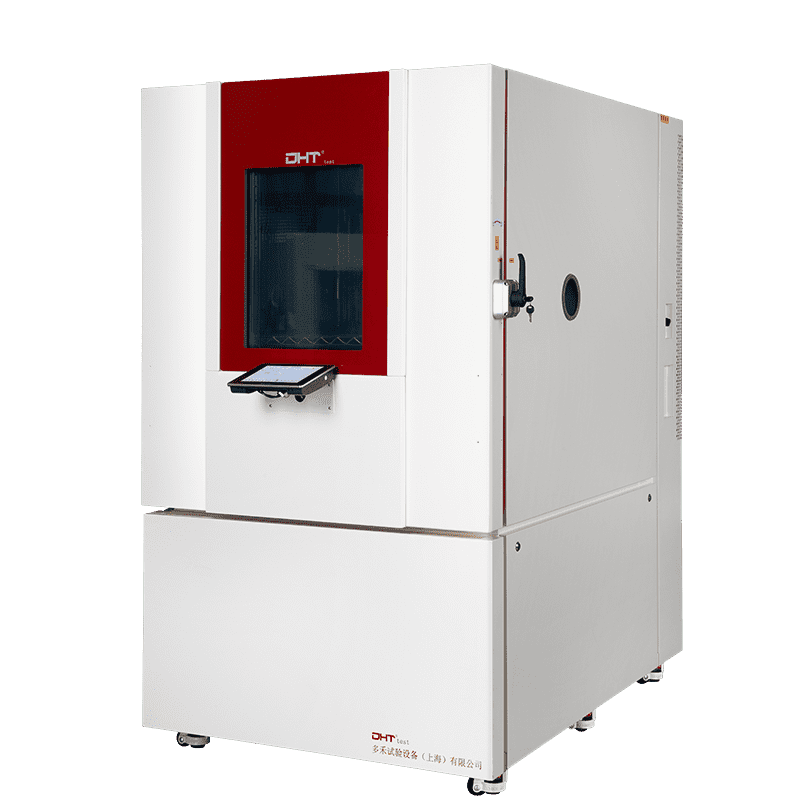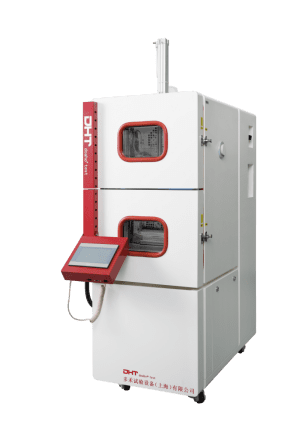Written by Shirley
Product Manager, Doaho Test (DHT®)
In the design and manufacturing of high-end electronic products, quality control goes far beyond functional testing. A critical focus lies in verifying the product’s stability and reliability under extreme environmental conditions. As a core method of environmental adaptability assessment, thermal shock testing has become an indispensable validation procedure in industries such as electronics, military, automotive, aerospace, and medical equipment.
But what exactly is thermal shock testing? And why is it a must for high-end electronics? This article will explore its technical principles, failure mechanisms, industry standards, and typical applications to provide a comprehensive understanding of this essential testing method.
What Is Thermal Shock Testing?
Thermal shock testing involves rapidly alternating a product sample between extremely high and low temperatures to simulate abrupt temperature changes that may occur in real-world scenarios—such as during environmental transitions, power cycling, or rapid heating and cooling of devices. The goal is to evaluate the structural integrity and functional stability of materials or products under sudden thermal stress.
This test is typically conducted in a thermal shock chamber, which often features a two-zone or three-zone structure. These chambers allow rapid temperature transitions within a range of -70°C to +200°C, and are designed to comply with international standards such as IEC 60068-2-14 and MIL-STD-202 Method 107.
Why Are High-End Electronics Especially Sensitive to Thermal Shock?
High-end electronic devices are often highly integrated and miniaturized, with internal components such as PCBs, solder joints, chips, and packaging materials that differ significantly in terms of physical structure, coefficient of thermal expansion, and conductivity. These differences make them especially prone to the following types of failures under thermal shock conditions:
● Solder Fatigue Cracks
Due to mismatched coefficients of thermal expansion (CTE) between different materials, repeated thermal cycling can cause micro-cracks in solder joints, leading to intermittent connections, open circuits, or short circuits—a common failure mode in BGA packages and fine-pitch components.
● Material Warpage and Delamination
Sudden temperature changes can cause delamination between layers in multi-material assemblies, weakening structural strength and potentially leading to circuit failures. This is particularly critical in flexible PCBs and composite materials.
● Functional Drift and Signal Noise
Analog and RF components are susceptible to parameter drift under varying temperatures, affecting signal stability, response time, and potentially causing accuracy degradation or malfunction.
In essence, thermal shock testing is not only a measure of product safety, but also a core strategy for ensuring long-term reliability and market competitiveness.
Which Industries Require Thermal Shock Testing?
● Aerospace and Military Applications
Devices must withstand rapid environmental transitions—from frigid high altitudes to ground-level heat. Even minor solder joint failures can lead to mission-critical errors.
Example: A UAV control module experienced frequent cold-start failures at high altitudes before thermal shock testing was implemented. After optimization, the failure rate dropped below 1%.
● New Energy Vehicles and Battery Management Systems
Key components such as BMS, inverters, and battery modules must endure repeated temperature cycling between cold-start and high-heat operation, ensuring system stability and safe thermal management.
● High-End Consumer Electronics (e.g., 5G smartphones, wearables)
Products designed for global markets must operate reliably in extreme climates, from Nordic cold to tropical heat. The demand for long-term reliability is pushing manufacturers to adopt more rigorous thermal shock testing.
● Medical and Laboratory Devices
Equipment used for direct contact with patients or biological samples must pass strict environmental verification to prevent measurement deviations or structural deformation caused by thermal changes.
Key Standards and Test Procedures in Thermal Shock Testing
A typical thermal shock test involves the following configuration parameters:
-
Temperature Zones: e.g., high temperature zone +150°C, low temperature zone -40°C
-
Transfer Time: usually less than 10 seconds, representing the time taken to move between zones
-
Cycle Count: typically ranges from 100 to 1,000 cycles, based on industry standards
-
Monitoring Metrics: temperature fluctuations, physical changes (e.g., deformation, cracking), and electrical performance shifts
Common international standards include:
-
MIL-STD-202 Method 107: U.S. military standard for electronic components
-
IEC 60068-2-14: International electrotechnical standard used in electronics and automotive industries
-
JEDEC JESD22-A104D: Widely used in the semiconductor sector
As a specialist in environmental simulation equipment, DHT® thermal shock chambers offer robust capabilities tailored for intensive thermal stress testing. Key features include:
-
Fast transfer response ≤10 seconds between high and low temperature zones
-
Temperature uniformity of ±1.5°C, ensuring consistent exposure across the sample
-
Integrated real-time monitoring and automatic alarm functions, enhancing test safety and efficiency
-
MES compatibility, allowing seamless integration with R&D and quality management systems
In an era of rising technical thresholds and increasingly complex application environments, thermal shock testing has evolved from a “nice-to-have” into a “must-have”. It not only verifies a product’s resilience under harsh conditions but also reflects a brand’s technological strength and depth of R&D.
If you’re seeking a high-performance thermal shock test chamber or want to explore how thermal shock testing can be implemented in your industry, contact the DHT® technical team. We’re here to support your journey toward unmatched product reliability.
FAQ
What Is Thermal Shock Testing?
Thermal shock testing rapidly alternates a product between extreme high and low temperatures to simulate sudden environmental changes. It evaluates the structural integrity and functional stability of materials and electronic products under abrupt thermal stress, typically conducted in two-zone or three-zone thermal shock chambers.
Why Are High-End Electronics Sensitive to Thermal Shock?
High-end electronic devices are highly integrated and miniaturized, with components like PCBs, solder joints, chips, and packaging materials that differ in thermal expansion and conductivity. This makes them prone to solder fatigue cracks, material warpage, delamination, functional drift, and signal noise under rapid temperature changes.
Which Industries Require Thermal Shock Testing?
Thermal shock testing is essential in aerospace, military, new energy vehicles, high-end consumer electronics, and medical devices. It ensures system stability, product safety, and reliability under extreme environmental conditions, helping manufacturers meet international standards like MIL-STD-202, IEC 60068-2-14, and JEDEC JESD22-A104D.


